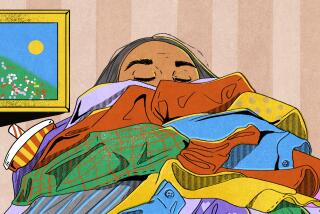Family Background of Clutter Leads to Orderly Closet
- Share via
It’s been said that college psychology classes are full of people trying to better understand themselves. I don’t know if that’s true, but it’s in that spirit of self-examination that I wrote a story on clothes closets.
Unlike most people, who wonder why their wardrobe is a mess, I’m puzzled about why mine is so straight.
Hangers all face the same direction. T-shirts and sweat pants are rolled into cylinders, each exactly 12 inches long. Running shorts and underwear are rolled into cylinders, each exactly six inches long.
My sock basket alone merits a prescription for tranquilizers. The socks are rolled into spheres and stacked pyramid style, like cannonballs at a national historic site.
This, against a family background of cultivated clutter beyond anything a closet could contain.
Our farm was overrun with knickknacks and bric-a-brac purchased for pennies, but easily worth twice that amount. The machine shed was strewn with a collection of antique clothes irons. The feed shed was stacked with empty suitcases. Three legged tables dominated one stall of the horse barn and two legged stools filled a corner of the hay barn.
The low point came when we turned the chickens out of the hen house to make space for a room-size cabinet that a defunct lumber store used to hold hundreds of different nuts and bolts. Meanwhile we continued keeping our loose hardware in coffee cans while coyotes ate the chickens.
Sensing an error in my family’s methodology, I started looking for an alternative way of ordering my existence, a task characterized by many backpacking trips, some of them months long. I learned two things:
Clothes like to be stored as a volume, rather than as a plane. Fold them flat and they shift around in your backpack, redistributing weight and generally resisting order. Roll them into cylinders and they stack neat as cordwood.
Second, that Antoine de St. Exupery, author of the “Little Prince,” figured it out a lot better than I could when he said that a perfect design was not one in which there is nothing left to add, but one in which there is nothing left to take away.
In practical terms that meant personal possessions needed for an indefinite stay anywhere will total no more than one’s body weight (roughly the baggage limit on international flights).
This I learned during the two years that I worked in California and Spain, during which time I ricocheted back and forth more times than I remember. My desk and dresser was a fiberglass dog cage formerly used to transport a German shepherd across the Atlantic.
Inside the kennel, four feet of nylon webbing had the central processing unit of my desktop computer snugly suspended near the top. That left just enough room underneath for two milk crates, one holding T-shirts rolled into cylinders exactly 12 inches long, the other holding shorts rolled into cylinders exactly six inches long and socks stacked in a pyramid.






